Introduction
China’s may regain its previous economic growth rate, and recover from the increasing capital outflows. The main challenge involves its rapidly enlarging current account and financial account in opposite directions. The outflows are mainly caused by the expected reduction in open market operations by the US Federal Reserve. China’s growth relies on the growth of its major trade partners. The EU and the US show signs of growth, which may have a positive impact on China’s balance of trade. The depreciating Yuan may also increase competitiveness. The current account has a surplus for each of the five years since 2009. The current account balance declined between 2009 and 2010. It regained momentum in 2012 with increasing levels of positive balances. The country reported financial account deficits for the last four years. Both imports and exports increased in the five-year period, except in 2012, which had a decline in the quantity of exported goods. China’s exchange rate market operates under a managed exchange rate system.
China relies on foreign exchange more than other countries. The appreciation against the USD can be explained by the global financial crisis, which reduced production, and exports by American and European firms. The depreciation towards the end of 2013 and the beginning of 2014 can be explained by the capital outflow from China. Another reason for the changes could be the reforms that allowed the exchange market to float a little bit since 2005. The Chinese authorities have allowed the currency to appreciate in trying to reduce the gap between the market equilibrium rate and the managed exchange rate. China has the highest interest rates among the group, which shows the expected risk in China is high. China has pursued monetary policies to increase the money supply through an economic stimulus package in 2009.
Japan has maintained low-interest rates, even though they are not matched with a high economic growth rate. The European Central Bank has set lower and lower interest rates since 2009. The US has maintained the same level of its prime interest rate in the five-year period. The Chinese economy is more reliant on exports, which explains its reduced growth during the global recession. The government has used taxes and an expansionary monetary policy to increase the availability of capital in targeted sectors. China may not regain its initial trend in the balance of payments in the short run because of the nature of its current account and financial account. They are increasing in opposite directions. However, it may regain the initial GDP growth rate in the short run.
Body
The balance of payments for China for the last five years
The categories for the current account, financial account, and capital accounts. (Statistical discrepancy)
Table 1. Source: Central Bank of the Republic of China (Taiwan)
Current account trend in the five-year period
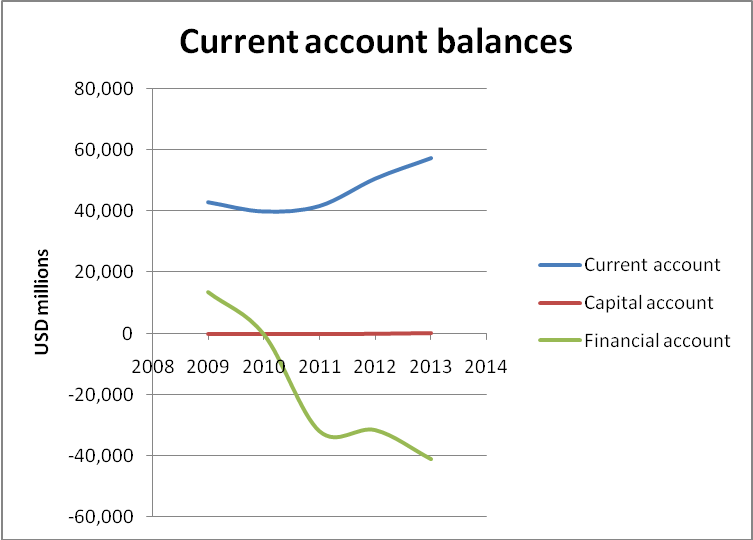
China’s current account surplus or deficit for each year
The current account has a surplus for each of the five years since 2009. The current balance declined between 2009 and 2010. It regained momentum in 2012 with increasing levels of positive balances.
China’s financial account surplus or deficit for each year
The country reported financial account deficits for the last four years. The company reported the first deficit of USD 358 million in 2010, followed by USD 32,046 million in 2011. By 2013, the deficit had grown to USD 41,164 million.
Changes over time
The deficits have increasingly become large towards 2013. As portrayed in graph 1, the financial account trend has a steep downward-sloping graph. It shows that the rate deficit in the financial account is increasing at a high rate. The current account is increasingly becoming larger positively when the financial account is increasingly becoming larger negatively. The capital account is fairly stable.
The reason China has the surpluses or deficits, and the reason they may have changed over this time
Table 2. Source: Central Bank of the Republic of China (Taiwan).
Both imports and exports increased in the five-year period, except in 2012, which had a decline in the quantity of exported goods. Services and income balances did not represent a decline in 2012. It follows that the decline in 2012 on exports, and the slower rate of growth of exports relative to imports are the main causes of the reduced balance of trade. Between 2009 and 2010, the balance of trade declined because imports are increasing at a higher rate than exports.
Table 3. Source: Central Bank of the Republic of China (Taiwan).
The deficit in the financial account may have been caused by increasing direct investments abroad, as shown in table 3. Investments in portfolio assets (equity and debt securities) also decreased by a large margin between 2008 and 2009, which declined from USD 3,527 million to USD -31,699 million. Two reasons can be listed for the deficit in the financial account. One is the increased borrowing, and the other is the increase in direct investment abroad.
The record of the data for the last five years for your country’s private Savings (S), Investment (I), Public Savings (T-G), and Current Account (CA) as a percentage of GDP. (Draw a graph in the body)
Table 4.
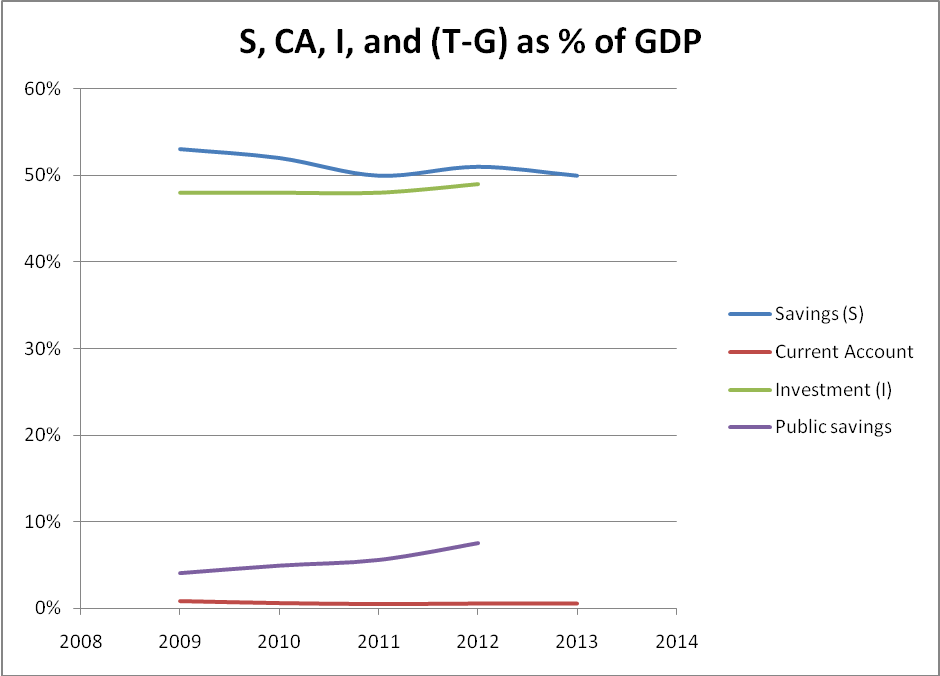
According to graph 2, the proportion of private savings (S) has a downward trend when public savings (T-G) has an upward trend. Aggregate investment has a fairly horizontal trend, which indicates that there is little change in their values. The current account is presented by itself in graph 3 because of its small-sized percentages. It shows a declining proportion. The current account regained stability between 2012 and 2013.
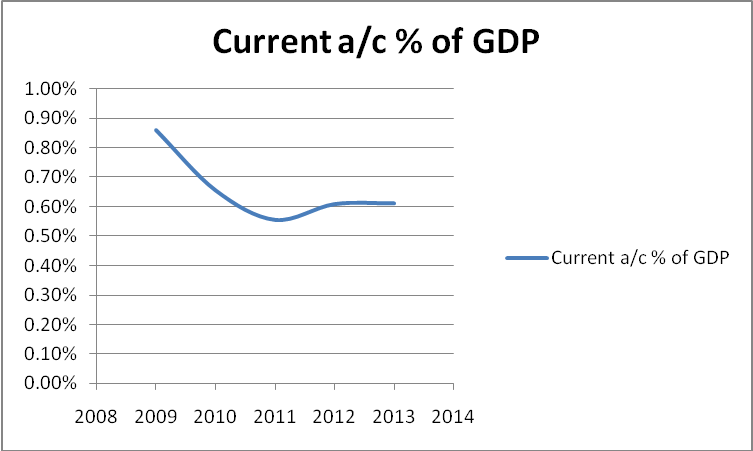
Currency
Primary currency used in China
The central bank in China is known as the People’s Bank of China, which has a mandate to issue circulating notes. The official name of its currency is known as the Renminbi. The unit of the currency is the Yuan (Triami Media BV par. 1).
Type of exchange rate system
China’s exchange rate market operates under a managed exchange rate system, which involves the government purchasing and releasing a large number of foreign currencies to keep it at the desired level. Morrison (26) explains that China carried out reforms on the foreign exchange market in 2005. It follows a managed exchange rate system instead of a floating exchange rate system against major currencies.
Chinese Yuan (CNY) today’s value against the US dollar, the Euro and the Yen
In April 2014, 6.2352 Yuan was exchanged for USD 1, and 1 Yuan has been exchanged for 16.4270 yen. It has been exchanged 8.6146 Yuan for Euro 1 (Fusion Media Ltd., table).
Comparison of the Yuan against the currency of the five main trade partners
Its five major partners include the US with USD 514 billion, Hong Kong with USD 401 billion, Japan with USD 312 billion, The Republic of Korea with 274 billion, and Taiwan with USD 197.28 billion (China Daily, 1-5). Morrison (21) includes the EU with USD 559 billion of total trade.
Trend
The USD and Euro have been presented in one graph for better comparison (see Appendix A, for tables). The values have been inverted for better comparison.
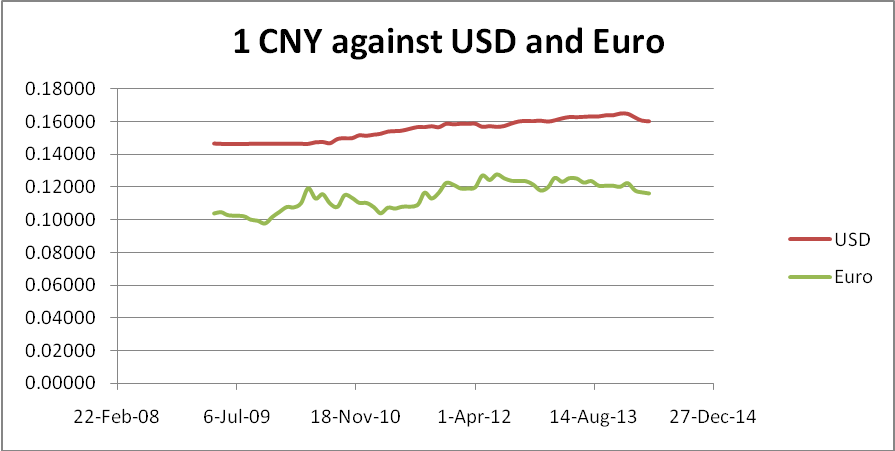

When 1 Yuan exchanges for more foreign currency, it indicates an appreciation of the Yuan. In graph 4 and graph 5, the Yuan has appreciated against the US Dollar, the Euro, the Japanese Yen, and the Korean Won. It is shown by an upward trend that indicates that 1 Yuan is exchanged for more of these currencies. The Yuan is fairly stable against the Taiwan Dollars and the Hong Kong Dollars. Towards the end of 2013, the Yuan showed signs of depreciating, as shown by a downward trend in the USD and Euro.
Dependence
China relies on foreign exchange more than other countries. Morrison (26) explains that China had about 60% of the GDP relying on net exports in the last decade. The Euro Area (28 countries) had 30%, the rest of Asia had 35%, and the G7 countries had 16% (Morrison 26). It shows that China relies more on the foreign exchange market than its major trade partners. Compared on their proportion of global trade, China accounted for 17.5% of global exports in 2013, and 21.1% of imports (JETRO, table). The US accounted for 18.9% of exports and 8.5% of global imports in 2013. Table 5 below shows that China is reliant on foreign exchange more than its major trade partners.
Table 5. Source: JETRO .
Recent shocks
The Yuan (CNY) has depreciated against the currency of its five major trade partners since January, 2014 (see Appendix A). It may be a move by the Chinese monetary authorities trying to create competitive advantage by creating a weaker Yuan. It can also be that there is less demand for the Yuan in the foreign exchange market.
The changes that have occurred in the foreign exchange rate against the five major currencies since January 2009. (Use monthly or quarterly figures)
The Yuan appreciated against the US dollar consistently since 2009, only showed signs of depreciation at the beginning of 2014 (see Appendix A). The Yuan depreciated against the Euro in October and November, 2009, and August and September, 2010. The Yuan appreciated in the other months. It appreciated at the beginning of 2012, and started to depreciate in the middle of 2013 (see Appendix A). It has been more volatile towards the Euro in the five-year period, compared with the other currencies. The Yuan had inconsistent fluctuations against the Korean won in the five-year period. It appreciated in some months of 2009, followed by depreciation in 2011, and appreciation in 2012. The Yuan started to depreciate against the Won towards the end of 2013, and beginning of 2014. The Yuan was fairly stable against the Taiwan Dollars and Hong Kong Dollars, but showed signs of depreciation at the beginning of 2014.
The three reasons for the changes in the Yuan’s exchange rate during the five-year period.
The appreciation against the USD can be explained by the global financial crisis, which reduced production and consumption by American and European firms and households. It resulted in less demand for USD by Chinese investors, and foreign consumers.
The depreciation towards the end of 2013 and beginning of 2014 can be explained by capital outflow from China. One of the reasons for the outflow of capital is the expected quantitative easing tapering by the US Federal Reserve (The People’s Bank of China 29). Quantitative easing (QE) tapering refers to the reduction of money supply by the government through open market operations. The reduction in the amount spent on open market operations is likely to increase market interest rates. The People’s Bank of China claims that “weak fundamentals in the emerging markets are the fundamental reason for the volatility” (30). Investors prefer the US to China when interests are similar because China is considered to have weak regulations. However, the expected QE tapering in the US affected most emerging economies such as Indonesia, Turkey, and India (The People’s Bank of China 32).
The third reason for the changes could be the reforms that allowed the exchange market to float a little bit since 2005. Morrison (26) discusses that the Chinese authorities have allowed the currency to appreciate in trying to reduce the pressure between the market equilibrium rate and the managed exchange rate.
The Yuan’s forward (either 30, or 90, or 180 days into the future) value today against the US dollar, the Euro and the Yen
The forward value for the US against the Yuan for 30 days is about 6.13 Yuan for 1 USD. It is 6.12 Yuan in 90 days, and about 6.02 Yuan for 1 USD in 180 days (Scotiabank 13). Most analysts forecast the dollar against major currencies, which makes it difficult to obtain a forward for the Yuan against the Euro, and the Yen. However, if the Yuan depreciates against the dollar as expected, it is likely to depreciate against the Yen, and the Euro.
Based on your country and the other three countries, what would explain (three reasons) this change in value over this time period?
The main reason that the Yen is expected to depreciate against the dollar is that the Chinese government is likely to take action to cause the Yuan’s depreciation by releasing more foreign currencies. It would like to maintain its competitiveness advantage.
Another reason is that America has more exports than imports. China’s imports are increasing at a higher rate than exports, which may result in a further deficit in the balance of trade. It may cause the Yen to become weaker.
The third reason is that the capital outflows may continue when the US government implements the QE tapering that was postponed in 2013.
Interest rate and GDP
China’s (prime or central) interest rate and real GDP values since January 2009 compare with the interest rates and real GDP in the US, EU and Japan. (Use monthly or quarterly figures).
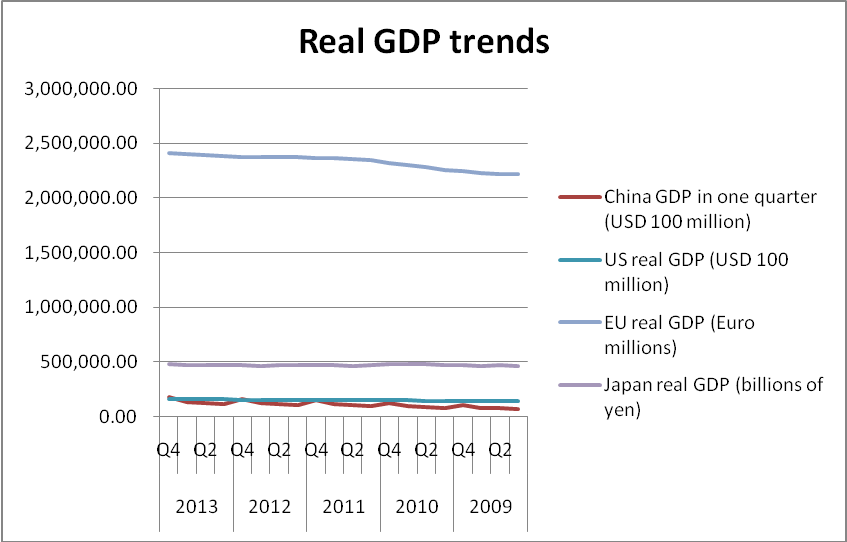
According to graph 6, the quartely real GDP shows that only the EU’s GDP has a strong upward trend, which shows consistent improvement. The US’ and China’s GDPs are also increasing, but a lower rate than the EU. China has more frequent quarterly fluctuations compared with the other economies. Japan is fairly constant (see Appendix B and Appendix C, for tables).

Sources: Bank of Japan (table), European Central Bank (table), FRED (table), National Bureau of statistics of China (table), OECD (table), The Peoples Bank of China (table), Triami Media BV (table).
China’s (prime or central) interest rate and real GDP figures compared with the interest rates and real GDP in the US, EU and Japan.
China’s central bank rate has been at 6% in the past one year. Japan has the second lowest interest rates, but its economic growth rate is the lowest in the group. The EU, through its European Central Bank (ECB), has integrated much lower rates in 2013 and 2014 than Japan. China has the highest interest rates, which may indicate that China is considered highly risky by banks and investors compared with the group. However, China had a real GDP growth rate of about 7.7% year on year, which is higher than in Japan (National Bureau of statistics of China, table). Only the EU indicates a higher growth rate as shown in graph 6.
The changes in value of these variables since January 2009.
China
In China, interest rates have increased since 2009, from 5.31% in the first quarter 2009 to 6.56% in 2013 (Q4), for the central interest rate. A major increase occurred in 2011 from 6.06% in the first quarter to 6.56% in the third quarter (The Peoples Bank of China, table). The GDP fluctuated frequently between 2009 and 2013 (see Appendix B). The GDP trend is that all first quarters have a lower GDP, and all fourth quarters have a higher GDP than the other quarters.
US
The US has maintained its prime rate at 3.25% since 2009. The quarterly real GDP has increased consistently in all quarterly figures. It shows an upward trend that does not change downwards (FRED, table).
EU
The interest set by the ECB have been reduced from 1.50% in the first quarter 2009 to 0.25% in the last quarter 2013, for the ECB fixed rate (European Central Bank, table). The ECB marginal rate has changed from 2.25% to 0.75% within the same period. The interest rates have reduced almost consistently within the EU. The EU real GDP is not consistent as that of the US. There are increases in some quarters, and decreases in others. However, the fluctuations are less frequent compared with those in China.
Japan
Interest rates fell from 2.30% in 2009 (Q1) to 1.20% in 2013 (Q4) for the long-term lending rate (Bank of Japan, table). The short-term lending rate remained constant during the five-year period at 1.475%. Japan’s quarterly GDP has fluctuations similar to China in frequency, although the margins are smaller.
Based on China’s values and the other three countries, the reasons for the change in the values over the five-year period.
Three reasons for the occurrence of the fluctuations
- The global financial crisis created a global recession that affected many countries. Most monetary authorities were trying to keep the interest rates low to encourage economic growth. It was seen in the US, the EU, and Japan. Only China shows increasing interest rates when all others are decreasing their interest rates. China reported economic growth, even after the financial crisis. The other economies were in recession, so they had to lower interest rates to increase the availability of credit for investment.
- China has been associated with high risk because there is inconsistency in enforcing contracts, and adhering to the rule of law (The People’s Bank of China 30). Higher risk has to be associated with higher interest rates.
- One of the reasons for the fall in growth rate in China, and its fluctuations is that China is reliant on exports more than the other countries. The other countries rely more on domestic consumptions than balance of international trade (Morrison 26). China relies on fixed asset investment, and exports. Relying on domestic consumption would reduce fluctuations.
The type of fiscal and monetary policies that China has pursued since January 2009. (Be specific: government spending, taxes, money supply, etc.)
China has pursued monetary policies to increase money supply through an economic stimulus package of $586 billion in 2009 (Morrison 2). The government also postponed the purchase of mature bonds, which maintains a high money supply. The People’s Bank of China (2) discusses that M2 money supply went up by 14.2%, year on year growth, in 2013. M2 represents currency, deposits, and checks. M0, which stands for currency in circulation, went up by 5.7% in 2013, to reach 5.6 trillion Yuan (The People’s bank of China 2). The increase in money supply is supposed to lower interest rates. Interest rates have begun to drop as it is indicated in 2014.
Another monetary policy implemented by the government is to control interest rates. The Chinese government launched a loan prime rate (LPR) system centralized quote, which is similar to the one used in the US. In the US, the prime rate considers 10 large banks. The Chinese made up a panel of 9 large banks (The People’s Bank of China 14). They want to create ability to lead other financial institutions in setting a common level of interest rates.
The government also uses taxes and incentives to target particular industries. Morrison (26) discusses that China lowers the cost of capital and engaging in the manufacturing sector.
Explanation for the changes in interest rates and real GDP from the fiscal and monetary policies that were implemented.
The LPR system and the increase in money supply can explain the falling interest rates in 2014. The fluctuations can be explained by the influence of the global financial crisis. China relied more on exports when the global recession took place. As a result, reduction in exports to the advanced economies caused the reduction in the GDP growth rate. The GDP growth rate was 9.6% between 2008 and 2011, and 7.7% between 2012 and 2013 (Morrison 2). The People’s Bank of China (36) explains that export growth rate dropped further after 2012.
The recovery in 2011, which occurred after the falling growth rate in 2010, can be explained by the stimulus package. Increased money supply creates more liquidity for investment.
The use of taxes and incentives on the manufacturing sector has resulted in higher growth in the manufacturing sector at the expense of other sectors. It distorts the utilization of resources from areas that provide the highest opportunity cost. On the other hand, China overtook the US as the major manufacturing country in 2010. In 2011, China’s “gross value added on manufactured commodities was 30.5% of GDP compared with 12.3% in the US, and 18.7% in Japan” (Morrison 8). It can explain the recovery that China has shown in 2013, after a decline in exports in 2010 and 2011. Table 6 below shows that the change in exports between 2012 and 2013 is larger than in the other periods.
Table 6.
Comparison of the changes in fiscal and monetary policies to the changes the current accounts since January 2009.
The current account declined in 2010 and 2011, and then it regained its balance in 2012. In 2013, there was a much higher increase. It shows that the government requires more money to carry out its expenditure. The financial account has grown more on the negative side, which shows increased borrowing to finance government operations.
Impact of the changes in fiscal and monetary policies in relation to the changes in the current account.
Increased expenditure requires the government to sell bonds, which is the case for a fiscal policy. In a policy that requires the government to issue economic stimulus packages, the government increases the money supply by electronically crediting the accounts of the persons that receive the amount. It is an expansion monetary policy, which increases the current account, and decreases the financial account.
Reducing taxes and issuing incentives on the manufacturing sector, decreases the amount that the government receives as income. It increases the current account, and reduces the financial account.
Conclusion
China’s current account and financial account have been increasing rapidly in opposite directions since 2009. The current account is increasingly becoming larger positively when the financial account is becoming larger negatively. The rate at which the two accounts are increasing is higher than in the earlier periods. The capital account has been fairly stable in the five-year period. China’s economic growth may have slowed down between 2010 and 2011, but it has shown signs of recovery in 2013. The increase in capital outflow was mainly caused by the expected reduction of quantitative easing by the US, which may indicate that investors prefer the US to China when interest rates are similar.
China’s manufacturing sector may continue to grow, even though it has been criticized for having excess capacity. It takes away resources from other alternative uses that would have given higher returns. The appreciation against the dollar may soon be contained if the Chinese government takes action to release part of its foreign reserves, as it has been its usual response, except for the last few years. The CNY appreciated because the government changed its system in 2005, and after 2009 it has tried to match the market equilibrium rate gradually. China’s may regain its previous economic growth, which relies on the growth of its major trade partners. The EU and the US show signs of growth, which may have a positive impact on China’s balance of trade in the long run. The depreciating Yuan may also strengthen competitiveness.
Appendices
Appendix A
Source: Fusion Media Ltd. (tables).
Appendix B
Sources: FRED (table), and National Bureau of statistics of China (table).
Appendix C
Sources: National Bureau of statistics of China (table). Bank of Japan (table). European Central Bank (table). The Peoples Bank of China (table). Triami Media BV (table). FRED (table).
Works Cited
Bank of Japan 2014, Prime Lending Rates (Principal Banks) from 2001. Web.
Central Bank of the Republic of China (Taiwan) 2014, Quarterly Releases. Web.
China Daily. 2014. Top 10 Trading Partners of the Chinese Mainland. Web.
Economy Watch 2014, Gross National Savings as a Percentage of GDP. Web.
European Central Bank 2014, Key ECB rates. Web.
FRED 2014, Economic Data. Web.
Fusion Media Ltd. 2014, EUR/CNY Historical Data. Web.
JETRO 2014, Japanese Trade and Investment Statistics. Web.
Morrison, Wayne. China’s Economic Rise: History, Trends, Challenges, and Implications for the United States, Washington, D.C: Congressional Research Service, 2014. Print.
National Bureau of statistics of China 2014, National Data. Web.
National Bureau of Statistics of China. 2014. Statistical Communique of the People’s Republic of China on the 2013 National Economic and Social Development. Web.
National Bureau of Statistics China 2014, Taxes. Web.
OECD 2014, Quarterly National Accounts Meta Data: Quarterly Growth Rates of real GDP, change over previous quarter. Web.
Scotiabank 2014, Foreign Exchange Outlook. Web.
The People’s Bank of China 2013, China Monetary Policy Report Quarter Three 2013. Web.
The Peoples Bank of China 2014, Financial Institutions RMB Benchmark Lending Rate. Web.
The World Bank 2014, Gross Capital Formation (% of GDP). Web.
The World Bank 2014, Gross Savings (% of GDP). Web.
Trading Economic 2014, China Government Spending. Web.
Triami Media BV 2014, PBC base interest rate – Chinese Central Bank’s Interest Rate. Web.